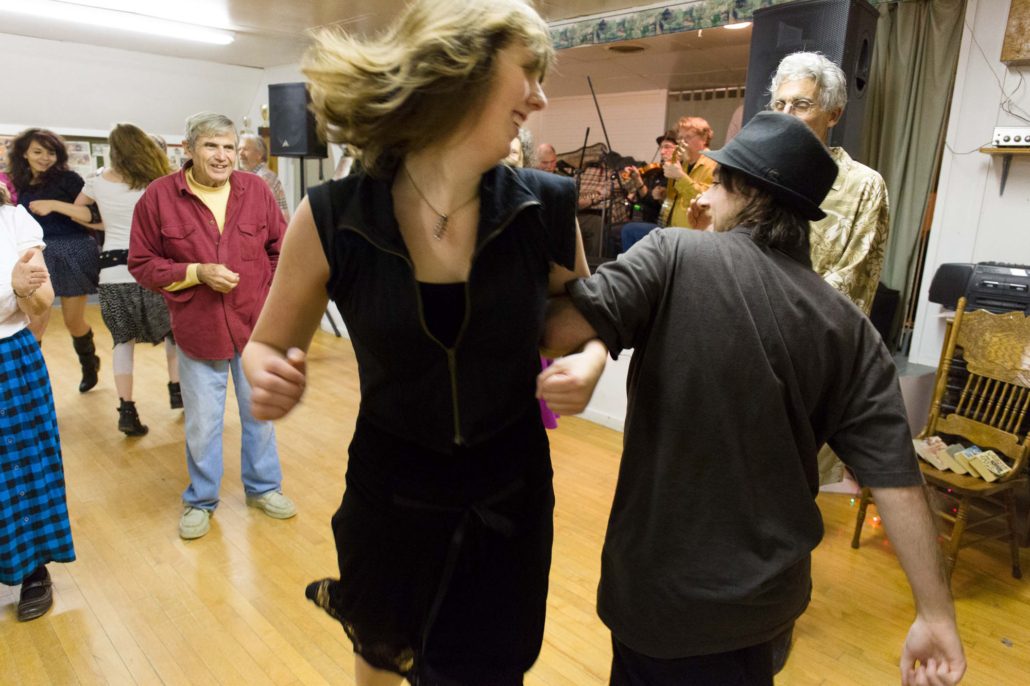Contradancing-old and new ongoing traditions
Old and new traditions

Crowfoot in Tacoma (from YouTube)
Contradancing is a lively family-friendly social dance that anyone can attend with or without a partner. Over the course of each dance, folks interact not just with their own partner for that dance, but with everyone else in the set. No experience is necessary and all dances are completely explained and “walked through” by the caller before the music starts. Since your feet are never asked to do more than walk to the beat of the music, many people find contradance easier to learn than other forms of social dancing.
A typical evening of contradance is three hours long, with a break after the first half. The band will usually play music for a waltz at the break and another waltz at the end of the evening. Water is provided and snacks to share at the break are always welcome.
Contradancing is usually done in a dance hall with a stage where the musicians play. The dancers form couples, and the couples form “sets” of long lines starting from the stage and going down the length of the hall. Throughout the course of a dance, each couple does a series of figures, not dissimilar to square dancing. Then they do the same set of figures with the next couple and so forth, progressing down the line, dancing with each of the other couples.
Almost all contradances are danced to live music. The music played includes, but is not limited to, Irish, Scottish, old-time, bluegrass and French-Canadian folk tunes. The fiddle is considered the core instrument, though other stringed instruments can be used, such as the guitar, banjo, bass and mandolin, as well as the piano, accordion, flute, clarinet and more. Music in a dance can consist of a single tune or a medley of tunes, and key changes during the course of a dance are common.
Here is a video by George Marshall where he introduces new people to contradancing. Some form of a lesson is usually provided at community dances before the actual dance starts.
So where did contradancing come from?
A little history:
We always tell people that contradancing comes from New England but, in fact, it has origins that go much further back.
There were English country dances some of which were documented by John Playford in 1651. Scottish Country Dance and Irish Dance followed. English country dances were also taken up by French dance masters who called these dances contredances. Eventually they came to New England where they were called “country dances” or “contradances.” Contradances were fashionable through the 19th century, mostly found in rural settings.
The contradance tradition continued in small towns in New England though were revitalized in the 1950s and ‘60s by callers Ted Sannella and Dudley Laufman.
In the 1970s, Sannella and other callers introduced dance moves from English Country Dance, such as heys by writing new, more modern dances. New dances, such as “Shadrack’s Delight,” by Tony Parkes, were at a faster pace.
Catch personal history of old New England contradances from our Maine blogger, Bill Olson where he interviews Syvia Miskoe.
Innovated musicians such as Rodney Miller and band The Fourgone Conclusions, started playing swingy and faster tunes for the dances. What started as traditional dances with long histories going back centuries, have, in the past 40 years, changed with the times. Musicians have been composing new tunes. Contradances, like all folk/roots music and dance, are a living tradition.
Starting around 2017, there has been a movement around the country towards what is called “gender free” contradances. In some communities, the gender free dances started as a way to have a safe environment for the LGBTQ+ community. Gender free terminology has become the norm for many contradances around the country.
Check out more about Gender Free Contradances.
[Modified from Contra Dance Wikipedia]
Take Hands film
Take Hands tells a small town story that has big current relevance. It is a story of how music and dance can unite people across cultural divides. The film follows contradancer Stacy Rose and the South Coast Folk Society as they organize a week-long celebration of traditional American music and contradancing in rural Coos Bay, Oregon. Stacy wants to everyone included in this celebration, no matter their skills or politics. Her goal is a week of dance that will bring people together and perhaps change a town.
———————————————————-
Your local dance is just a Google search away. One good site to start with is trycontra.com.
———————————————————-
Country Dance & Song Society
Country Dance & Song Society is a national nonprofit organization that promotes different types of participatory dance, including contradance, English country dance, square dance, Morris dance, rapper sword, and clogging.
They have a YouTube channel with videos of interest to callers and folks who want to dig deeper into contradance. Here is a YouTube Playlist called Cracking Chestnuts put together by CDSS.
They also have two Podcasts that features interviews with musicians and callers. Subscribe on your favorite Podcast App.
For full disclosure, FolkWorks is a group member of CDSS. You can support CDSS and become a member yourself.
















 Take Hands film
Take Hands film










